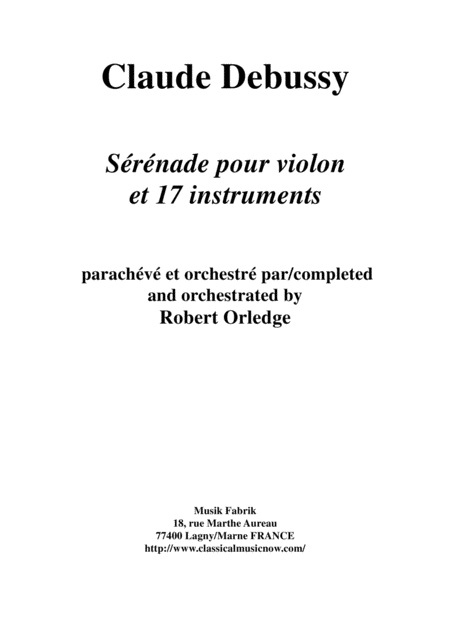Chamber Orchestra - Level 4 - Digital Download SKU: A0.1080705 Composed by Claude Debussy/Robert Orledge. 20th Century,Romantic Period,Standards. Score and parts. 30 pages. Musik Fabrik Music Publishing #4727447. Published by Musik Fabrik Music Publishing (A0.1080705). Instrumentation2 flûtes/2 flutescor anglais (doublant hautbois/doubling oboe)clarinette en La/clarinet in Abasson/bassooncor en Fa/horn in Fpercission (1 éxecutant - timbales (3)/cymbale suspendue, tambour de basque)/percussion (1 performer - timpani (3)/suspended cymbal, tambourine)harpe/harp9 cordes/9 strings (2.2.2.2.1)durée/duration: 5 minutes 30 secconds (environ/approx.) Une versions pour violon et piano ainsi quâune version pour violon et orchestre (31CA(hb)23/2100/timb/perc/hpe/cordes)est également disponibile/A version for violin and piano as well as a version for violin and orchestra (31EH(ob)23/2100/timp/perc/strings) is also available.______________________Prmière: Edmond Agapian, violin with the Calagray (CA) Youth orchestra, cond. Gareth Jones, University of Calgary, 28 Janaury, 2011Première of the version for violin and 17 instruments: Frédéric Moisan, violin Orchestre 21 cond. Paolo Bellomio, Unveristy of Montreal, Canada, 2 March 2012Preface:In the early 1890s, Debussy composed the opening of a lyrical piece in E major for violin and piano, perhaps as a shorter companion piece for the violin Nocturne he was planning for the Belgian violinist Eugène Ysaÿe. After Debussyâs death in 1918, his second wife Emma often gave away sketch pages to performers or composers as memorials to her beloved husband , and this particular page was given to the Cuban born pianist and composer Joaquin Nin (1879-1949). It came up for sale in the catalogue of the British antiquarian dealer Lisa Cox in 2010 and although it might possibly be an early song for contralto and piano, the more dynamic idea in bar 12 strongly suggests the violin, especially as it begins on an open D string. Moreover, there is no text and in pieces of this length, Debussy usually wrote at least one word in, if only to remind himself where he had got to in any song. So my starting point was a complete 12-bar melody gently undulating in the violinâs lowest register over a sensual accompaniment, rising to a climax in bar 12 and giving me a contrasting idea that I could use as a link between sections and in the cadenza. As the B section (bars 14-26) derives directly from Debussyâs opening theme by metamorphosis, my own additions were restricted to the central section (bars 27-57) - comprising a new scherzando idea (C) and the more lyrical D (bars 36-46). C returns at bar 47, followed by the opening sections in reverse order, so that the Sérénade begins and ends with Debussyâs material and is cast in arch form (ABCDCBA). Robert OrledgeBrighton, 19 June 2019Robert Orledge was born in Bath in 1948 and educated at Clare College, Cambridge, where he gained his doctorate for his study of the composer Charles KÅchlin in 1973. Between 1971 and 1991 He rose from Lecturer to Professor in the Music Department of the University of Liverpool, publishing books on Gabriel Fauré, Claude Debussy, Charles KÅchlin and Erik Satie, as well as numerous articles, editions and reviews. As a historical musicologist, Professor Orledge specialized in the way composers composed, ,and since taking early retirement in 2004, he has concentrated on completing and orchestrating Debussyâs unfinished works, and especially his theatre projects. His completion of Debussyâs opera The Fall of the House of Usher (1908-17) was successfully premiered at the Bregenz Opera Festival in Austria in August 2006 and has since been performed in America, Portugal Germany and Holland, as well as being broadcast throughout Europe. A DVD of the Bregenz premier is available on Capriccio 93517, produced by Phylida Lloyd and conducted by Lawrence Foster. His completion of the Chinese ballet No-ja-li ou Le Palais du Silence (1914) was also premiered in 2006 in Los Angeles and ot.
